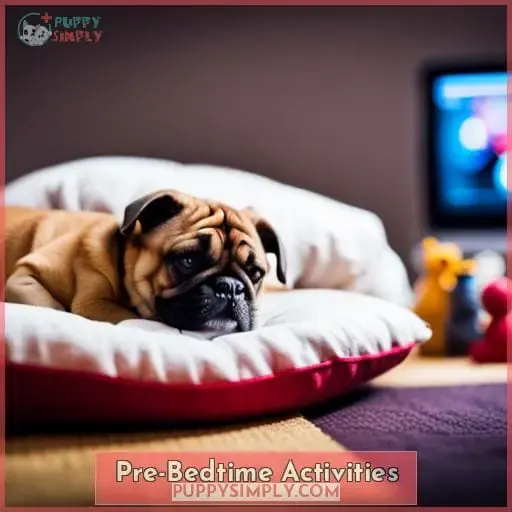This site is supported by our readers. We may earn a commission, at no cost to you, if you purchase through links.
Do you have a puppy that can’t seem to sleep through the night? You’re not alone. Many owners find themselves asking, Do dogs sleep all night? The answer is yes – but it depends on your pup’s age and other factors.
To help ensure your four-legged friend gets enough rest, this article will explore how much do dogs sleep by age and provide tips for improving their sleeping habits.
Table Of Contents
- Key Takeaways
- How Much Do Dogs Sleep by Age?
- Factors Affecting Sleep
- Improve Sleep Quality
- When to Visit the Vet
- Where Should Puppy Sleep?
- Crate Setup for Comfort & Safety
- Exercise & Brain Games
- Pre-Bedtime Activities
- 1 Give them chew toys that are designed for their breed and size to develop appropriate chewing habits.
- 2 Offer a variety of treats to keep their interest high while mastering different sniffing techniques.
- 3 Let them lick ice cubes or peanut butter off the floor – this helps soothe sore gums from teething as well as occupy their minds with stimulating tasks and provide calming effects.
- 4 Provide snuffle mats filled with treats or kibble that encourage mental stimulation through scent-finding games; creating a positive association between sleep time smells like lavender, chamomile, etc., increases sleep quality!
Key Takeaways

- Puppies require frequent naps during the day and may not sleep through the night.
- Adult dogs typically need 12-14 hours of sleep per day and can sleep through the night.
- Senior dogs may need more sleep due to a slower metabolism and require extra TLC for a good night’s rest.
- Establishing a consistent sleep schedule, providing comfortable bedding, and using calming tactics can help improve a dog’s sleep quality.
How Much Do Dogs Sleep by Age?
Are you curious about how much dogs sleep by age? To understand this, it’s important to look at the sleeping habits of puppies, adult dogs, and senior dogs. Puppies require frequent naps during the day as they grow and develop, while adult canines typically need an average of 12-14 hours of sleep per day.
Senior pooches may find themselves dozing off more often than before due to a slower metabolism.
Puppies
Puppies require extra attention and patience to help them adjust to a new environment, and establishing a routine for sleep is key in giving your pup the best possible start in life.
Exercise requirements should be met prior to bedtime, while crate placement should provide enough room for comfort without being too large or small.
Feeding habits can also affect a puppy’s sleeping patterns; feeding three hours before bedtime helps ensure they are not hungry during the night.
Regular potty training sessions throughout the day will further aid nighttime sleep as puppies learn where it is acceptable to relieve themselves.
A snuggle puppy provides added security when transitioning from the mother’s care into their forever home, creating an emotional safety blanket with its heartbeat sound and heat pack feature that soothes puppies into slumberland faster than ever before!
The type of crate used can also influence how much a dog sleeps by age—a cozy space away from noise distractions allows a puppy’s body temperature to remain regulated all throughout the night, promoting better restorative sleep cycles overall.
Having comfortable bedding inside adds another layer of relaxation on top of everything else.
Experimenting with different types of beds allows you to find what works best for your furry pal’s individual needs—whether it be memory foam, pillows, or blankets!
With dedication and consistent effort over time, these tips will have your little one resting peacefully throughout the nights ahead.
Adult Dogs
You may be surprised to know that adult dogs need just as much sleep as puppies, with an average of 12-14 hours a day! Make sure your furry friend is getting the rest they deserve by providing them with a comfortable space away from noise distractions.
A crate placed in an area where the dog feels secure can help them relax and fall asleep faster. Different breeds require different amounts of sleep depending on their age. Older dogs tend to have longer periods of rapid eye movement (REM) compared to younger ones who alternate between REM and non-REM more frequently during their sleeps.
Dog owners should also consider walks before bedtime when it comes to creating nightly routines for their pup. Potty training is essential for reducing nighttime accidents in both puppies and adult dogs alike! Additionally, choosing appropriate bedding based on temperature preferences will ensure that your pooch gets enough quality shut-eye throughout the night.
With patience, understanding, and dedication from its owner combined with adequate preparation prior to bedtime each evening, an adult dog can get all the relaxation needed regardless of its age.
Senior Dogs
Seniors require extra TLC to get a good night’s rest, so make sure your aging pup has the necessary tools and environment for optimal sleep. Exercise levels in senior dogs tend to be lower than younger ones, and they will need more frequent potty breaks overnight.
Crate setup should include comfortable bedding that fits their size well – too much space can lead to urinary tract infection issues or joint pain from sleeping on hard surfaces.
Setting up consistent sleep schedules is key when it comes to helping seniors fall asleep at night; try introducing calming puppy bedtime activities such as puzzle feeders or interactive toys before settling into the crate for better results! With patience and dedication along with proper training techniques, you can ensure your senior dog gets enough quality shut-eye each evening without any nighttime accidents.
Factors Affecting Sleep
Are you wondering about how much sleep your dog needs? Age, breed, rapid eye movement (REM), exercise, and surroundings are all factors that can affect a dog’s sleeping patterns. Knowing the specifics of these components is essential to ensuring your pup gets enough rest each night for optimal health.
Let’s take a deeper dive into the details of doggy slumber and explore how different elements influence their overall well-being.
Age
At any age, your furry friend needs to get the right amount of rest for a healthy and happy life. Training is important as puppies need to learn how to sleep through the night in their own separate space.
Stress levels can be managed by providing proper comfort and adjusting potty schedules. Behavioral changes occur when dogs are not getting enough hours of sleep due to their age or environment.
Breed
Certain breeds of dogs are more prone to sleep disturbances than others, with some pooches requiring extra-special care and attention for good rest. Crate training is a great idea as it provides security and comfort while following veterinarian-recommended sleep hygiene.
Depending on the breed, naptime needs can vary from one kind of dog to another, so be sure that you understand your pup’s specific requirements when creating their sleeping environment.
With patience and dedication, you’ll find the perfect balance between providing them with enough exercise during the day to tire out before bedtime but not too much stimulation, which can interfere with getting quality zzzs!
REM
You’ll be amazed at how your pup’s sleep patterns change with the right amount of REM sleep! To achieve optimal rest, you should focus on:
- Crate Setup: Ensure a comfortable sleeping environment by getting the right size crate and adding a crate cover to block excess light and noise.
- Comfort Levels: Create an inviting atmosphere with thick bedding that conforms to their shape for maximum support.
- Exercise Routine: Give them enough activity during the day so they’re tired before bedtime but not overly stimulated or exhausted before nap time arrives! Dr. Brian Evans suggests having puppy potty breaks throughout the day helps your pup’s health as it adjusts to its new age regime.
Nighttime potty breaks might also help in achieving quality slumber too if needed based on the dog’s age.
Exercise
Exercising your pup throughout the day can help tire them out and lead to a peaceful, restful night. Dr. Georgina Ushi Phillips suggests nightly exercise for puppies as it helps exert much energy that is otherwise used on destructive behaviors like barking or chewing shoes during the night.
Brain games, such as puzzle feeders, also challenge pups mentally while having fun at dinner time! Timely potty breaks should be encouraged before bedtime to prevent accidents. Comfort toys, like Snuggle Puppy, provide security when transitioning to sleeping alone in their crate.
Soft, calming music, such as classical or reggae, has been known to soothe dogs into dreaming of puppy paradise. Research shows that certain types of music help relax fur babies and induce sleep quicker than others! With patience and dedication, our four-legged friends will soon start snoring through the night with ease (and no need for coffee!).
Surroundings
Creating a peaceful environment for your pup to sleep in is just as important as exercise. To achieve this, consider potty training strategies such as restricting water access at night and setting an alarm for quick potty breaks during the night.
Adjustment periods and crate setup tips from Preventive Vet staff review are also key elements of creating a calm environment.
Improve Sleep Quality
By managing your pup’s environment, diet, and activities during the day, you can help improve their sleep quality at night. Establishing a regular potty training schedule will allow them to go outside when they need to, thus preventing any accidents from occurring in the bedroom.
Setting up a comfortable sleeping area with plenty of bedding is also important for helping your pup get some restful sleep each night. Additionally, providing calming tactics such as soft music or white noise machines can lower stress levels that may be keeping them awake at night.
When it comes time for evening meals, try using puzzle feeders like Puppy Fozzie Bear, which engages their mind while eating and helps tire them out before bedtime.
If you have an older dog who suffers from sleep apnea, then checking with your vet on ways to regulate breathing patterns during slumber might be beneficial too! Lastly, don’t forget about exercise; not only does it keep dogs healthy, but getting active throughout the day helps promote better nighttime rest as well!
There are several things pet owners should consider when trying to ensure their dog’s age-appropriate amount of shut-eye per 24-hour period, including creating routine daily schedules, setting up suitable bedrooms, introducing calming techniques such as music or white noise machines, engaging meal times through interactive toys & puzzles like Puppy Fozzie Bear & snuffle mats, and finally monitoring stress levels by exercising regularly throughout the daytime hours.
With patience and dedication, over time these methods combined could increase chances of longer uninterrupted periods of doggy zzz’s – all leading towards happier canine companions.
When to Visit the Vet
After taking all the steps to ensure a good night’s sleep for your pup, it may be time to visit the vet if you still notice that their nighttime routine isn’t improving. It could be due to underlying medical conditions or age-related issues such as arthritis, hip dysplasia, or other mobility problems.
Crate training has been known to help create structure, which ultimately leads to better sleeping habits in puppies. During potty breaks outside of crate times, make sure not too much water is consumed before bedtime to prevent accidents during nighttime hours when puppies are fast asleep.
Keep puppy pads nearby just in case! Meal times should also take place earlier in the evenings rather than later at night. This will reduce hunger pains, which keep them from getting comfortable enough for proper shut-eye sessions.
It’s important to provide comfort items like beds and blankets for extra warmth and coziness. Calming sounds, such as classical music or white noise machines, also contribute greatly alongside Adaptil pheromone diffusers/sprays used throughout dog rooms/houses.
For those whose dogs require more attention than normal due to the age-appropriate amount of shut-eye per a 24-hour period, seeking advice from vets would definitely be recommended too. Alongside monitoring stress levels through regular exercise routines during the daytime, this helps promote deeper levels of slumber come dark hour fallings.
Where Should Puppy Sleep?
Finding the perfect spot for your pup to snooze can be a challenge, but with some trial and error, you’ll soon discover where they feel most comfortable and secure. Dr. Pedro M. Aponte recommends proper crate positioning at night, which is important for both safety reasons and allowing them to settle into their sleep cycles more easily than if it were in an unrestricted area of the house that had too much light or noise present throughout the night hours.
Choosing appropriate toys should also factor into bedtime habits. This includes offering chewable items like puzzle feeders filled with kibble or crunchy treats prior to heading off for dreamland. These help engage pups’ brains while providing nourishment before settling down! If you’re looking for something even more engaging, consider stuffing Kongs with peanut butter or yogurt and freezing them overnight.
Potty routines are paramount during this period of adjustment. Being able to predict when pooch’s will need bathroom breaks helps understand their natural rhythms better over time, leading up until having long nights uninterrupted by potty trips outside.
Puppy pads near crates are always a good option just in case though! Having patience is key here.
Finally, swapping out blankets every now and again could be a better option since unpleasant odors can develop over time due to regular use. Remember: hygiene first & foremost! With consistency comes reward & success eventually, so make sure not to forget that part either.
Crate Setup for Comfort & Safety
Creating a safe and comfortable sleeping environment for your pup is essential to helping them sleep through the night. One important step in this process is setting up their crate properly with a cover and comfortable bedding.
Additionally, providing stimulating activities during the day will help tire out your pup prior to bedtime, ensuring they get much-needed rest each night.
Start by selecting an appropriate crate cover that blocks outside light and noise, which can disrupt sleeping patterns. Then, choose the right type of bedding that provides cushioning support for their joints while still being easy to clean up after accidents or spills.
Use a Crate Cover
A crate cover can provide extra security and comfort for your pup, creating a calming environment to help them settle into sleep. This is especially true for puppies who may be in the midst of potty training or adjusting to new meal times.
Crate covers aid in proper development as they block out excessive light and noise while helping regulate puppy energy levels throughout the day with frequent naps.
Keeping up with their age-appropriate sleep/wake cycles provides optimal growth potential, instilling healthy habits that can last until adulthood!
When selecting a crate cover, consider factors such as size (determined by the dog’s age), material type (cotton/polyester blend vs ripstop), imprints on design (reflective stitching), and overall thickness for added support and warmth during colder months too!
Plush blankets are also great options since they keep pups cozy without restricting movement like some other fabrics do when weighted down over time.
Lastly, adding chewable items from puzzle feeders to licking mats helps engage puppies’ minds before bedtime, allowing them more restful nights at shorter intervals if needed – all key pieces towards better whole night slumbers eventually!
Comfortable Bedding
Providing comfortable bedding is essential for helping your pup get the restful sleep they need during their age-appropriate sleep/wake cycles.
Crate placement and bedding types are key factors to consider when setting up your dog’s sleeping area. Soft plush blankets can keep dogs warm and cozy while providing much-needed comfort. Memory foam pet beds conform to a pup’s body shape, relieving pressure points from joints due to arthritis or hip dysplasia.
For extra warmth at night, turn on a sound machine playing calming music such as classical tunes or soft rock reggae rhythms.
Finishing off with calming aids like the ADAPTIL Dog Calming Diffuser Kit may help reduce stress levels in puppies while crate training them through the night.
Exercise & Brain Games
To help your pup have a restful night’s sleep, plan for regular evening exercise and brain games. An hour of playtime will tire them out, making it easier for them to settle down at bedtime, while activities like puzzle feeders or interactive toys can provide an engaging mental challenge.
With the right balance of physical activity and stimulating mind games before bedtime, you can help ensure that your pup gets the peaceful slumber they need each night.
Evening Exercise
To give your pup the best chance of snoozing through the night, it’s important to provide them with plenty of exercise and mental stimulation in the evening. Make sure to plan ahead for these activities by setting aside time each day before bedtime.
Variety is key when it comes to both physical activity and mental stimulation – providing different types of exercises or brain games can help keep things fresh for your pup while still helping tire them out.
Aim for at least 30 minutes a day prior to their last-chance potty break just before bedtime.
Mental stimulation such as puzzle feeders is especially beneficial because they require problem-solving skills, which can be mentally tiring yet rewarding at the same time! According to Dr. Phillips, this routine should become part of a puppy’s entire life from early on so that sleep routines become part of their natural habits even into adulthood.
Evening exercise and brain games will help ensure that puppies have burned off energy prior to going into nighttime crate setup, allowing them to go peacefully when it’s time to turn in for a goodnight rest.
Evening Brain Games
Offering engaging brain games in the evenings can help your pup stay mentally stimulated and tire them out for a better night’s rest. Puzzle feeders, brain-engaging toys, and snuffle mats are all great options that require problem-solving skills to keep things interesting.
Creating a potty log to identify when your puppy needs quick potty breaks throughout the evening is also beneficial in preventing any late-night accidents.
Additionally, white noise or sound machines can create a soothing environment for puppies while they sleep.
Pre-Bedtime Activities
Before your pup settles in for the night, it’s important to provide them with calming activities that involve licking, chewing, and sniffing. Activities like using a snuffle mat or scattering food can help engage their senses, while interactive feeders and toys give them an engaging mental challenge.
By providing these pre-bedtime activities for your pup each night, you’ll ensure they are relaxed enough to get the peaceful slumber they need.
Licking, Chewing, Sniffing
You can help your pup settle before bedtime by providing activities that encourage licking, chewing, and sniffing.
1 Give them chew toys that are designed for their breed and size to develop appropriate chewing habits.
2 Offer a variety of treats to keep their interest high while mastering different sniffing techniques.
3 Let them lick ice cubes or peanut butter off the floor – this helps soothe sore gums from teething as well as occupy their minds with stimulating tasks and provide calming effects.
4 Provide snuffle mats filled with treats or kibble that encourage mental stimulation through scent-finding games; creating a positive association between sleep time smells like lavender, chamomile, etc., increases sleep quality!
Lastly, remember all puppies have individual needs based on age range (not just puppy vs adult), breed type/size/temperament combination – it takes a lot of time spent observing your pup’s behavior in order for you to determine what will work best for her when trying to establish good sleeping patterns, whether it’s a new puppy or an older dog who’s having trouble getting restful nights.
Snuffle Mat & Scatter Food
Engage your pup’s nose for a peaceful night’s sleep by providing them with a snuffle mat and scattering food in it. The combination of licking, chewing, and sniffing helps puppies settle before bedtime.
This encourages crate training, which is beneficial for nighttime sleep and establishes good sleeping patterns early on.
Topping off the puppy’s long days with calming activities, such as family member interactions or mellow music, can greatly improve their ability to relax at nightfall. As an additional aid, use an Adaptil pheromones diffuser or spray that mimics the mother dog’s nursing hormones to provide a comforting environment for your pup at home during those restless nights when transitioning into becoming part of the family unit while learning about its own individual sleep-wake cycles.
Allowing time throughout the day spent engaging in calm puppy bedtime activities will ensure they have no energy left by evening, so they can drift off into dreamland without issues!
Interactive Feeders & Toys
Provide your pup with interactive feeders and toys to ensure they have a peaceful night’s sleep. Puzzle feeders, like the Zogoflex Toppl Dog Puzzle Toy, can be filled with treats or kibble to prolong playtime while helping them learn how to entertain themselves.
Filling up their Freeze Meals in a Toppl toy is also an excellent way for pups who eat too quickly at mealtimes. Licking mats are soothing tools that help engage a puppy’s nose and provide comfort during transition periods such as crate training or new partners joining the family unit – great for Great Danes! Additionally, white noise machines create calming environments perfect for a dog’s sleeping needs; from classical music selections all the way through reggae tunes – there are plenty of options available on today’s market! Adding comfortable bedding along with crate covers will block out excess light and sound, which further helps doggies drift off into dreamland without any issues after considering all aspects of their physical and mental health when it comes down to meeting desired results regarding the query do dogs sleep all night.
Potty Breaks & Meal Times
After your pup has had some time to burn off energy and engage in activities that involve licking, chewing, and sniffing before bedtime, it’s essential to consider their potty break needs as well as meal times.
Setting up the right crate is one of the most important factors for a puppy’s sleep-wake cycles. Comfort levels can affect how quickly they fall asleep, so make sure you provide plenty of soft bedding options within their crate setup or outside in case they need to move around during the night.
Establishing an exercise routine helps them adjust better into a sleeping pattern, but also remember that puppies require a lot of attention during this adjustment period, so be prepared for early morning wakeups when setting later schedules.
Potty breaks are crucial since any accidents at nighttime could lead to difficulties with bathroom training down the road.
The same goes for meal timing: feed earlier rather than later if possible since hungry pups may have difficulty settling until after being fed!
Lastly, consider giving water access restrictions closer towards bedtime just like us humans do.
All these steps together aid in helping your puppy achieve peaceful slumber through establishing consistency and routines from early stages – patience is key here though because although gradual progress should start soon enough, there’s still lots more learning involved along this journey ahead!
Comfort & Calmness
Finding a way to help your pup get the best night’s sleep possible can be difficult, but luckily there are many resources and tools available.
To ensure comfort and calmness for your dog during their nighttime rest, consider adding Snuggle Puppy with its real-feel heartbeat and heat pack to their bedding area. You can also use Dog Appeasing Pheromones (DAP) such as Adaptil Pheromone Diffuser or Spray.
Another option is playing calming sounds like classical music, soft rock, or reggae.
All of these methods have been proven to reduce stress levels in dogs before they go to bed, which leads them into a more peaceful sleep cycle.
Snuggle Puppy
For a gentle and calming transition into sleeping alone, the Snuggle Puppy provides your pup with a security blanket featuring an adorable heartbeat sound and heat pack to soothe them.
A puppy’s sleep-wake cycles are important for crate training success. Chew toys, bed types, and snuggle mats all work together in creating comfort levels that allow your pup to get quality rest. Factors such as anxiety or stress may also play a role in disrupting their natural patterns – but never fear; by setting routines early on, you can help create calmness during those difficult times.
Dog Appeasing Pheromones
You can harness the power of nature with Dog Appeasing Pheromones, which act like a calming breeze to help your pup drift off peacefully at night. DAP spray and Adaptil diffuser are effective drug-free solutions to reduce stress in dogs.
Puppy potty training is an important task that also affects sleep quality as constant waking disrupts the lower amount of deep sleep needed for proper rest. Establishing a new puppy’s sleep schedule with consistency can be made easier by using dog appeasing pheromones such as DAP spray or diffuser near the crate or bedding area while keeping the pup occupied during the day and providing quick potty breaks when needed.
With patience, your pup will soon settle into their own natural rhythm, snoozing soundly through the night!
Adaptil Pheromone Diffuser
Try out the Adaptil Pheromone Diffuser to help create a calming atmosphere for your pup and encourage them to get their much-needed rest. This drug-free solution helps reduce common signs of stress in dogs by mimicking a mother dog’s nursing pheromones.
Additionally, you can use nighttime potty breaks, crate training, sound machines, or a white noise machine to adjust your pup’s sleep-wake cycles and improve sleep quality. Sleep veterinarians recommend setting up an alarm for quick potty breaks during the night and establishing consistency with a new puppy’s sleep schedule using patience and dedication.
Combine this with the Adaptil Pheromone Diffuser, which comes preloaded on an SD card.
Calming Sounds
Listen to calming sounds like classical, soft rock, or reggae music in the evening to help your pup relax and drift off into a peaceful sleep. Sleep veterinarians recommend setting up an alarm for quick potty breaks during the night and establishing consistency with a new puppy’s sleep schedule using patience and dedication.
Keep track of your pup’s bathroom needs by creating potty logs so you can adjust meal times if necessary.
For crate comfort, be sure not to disturb their environment when they wake up during the day—free access is essential! With these tips in mind, you’ll finally have some peace knowing how much sleep your furry friend is getting each night.
Frequently Asked Questions (FAQs)
How can I tell if my puppy is getting enough sleep?
Most puppies get a full night’s sleep by the age of 4 months, so check your puppy’s age and adjust your expectations accordingly.
What are the long-term benefits of crate training?
Crate training your pup offers long-term benefits, such as reducing anxiety and providing comfort. This aids in establishing a secure environment for your pet to develop good sleeping habits, while also allowing them to explore their independence safely.
How do I know if my puppy has a sleep disorder?
If your puppy consistently fails to get a good night’s sleep, they may have a sleep disorder. Look for signs such as restlessness and hyperactivity during the day, vocalizing in the middle of the night, frequent waking, or difficulty settling down after being awakened.
If you suspect an issue exists, consult with your vet for diagnosis and treatment options.
What should I do if my puppy wakes up during the night?
If your puppy wakes up during the night, try to identify the cause. Could it be hunger, anxiety, or a need for potty? Adjust their meals and provide calming aids like snuggle toys with heartbeat sounds.
Create an environment that is safe yet stimulating by using puzzle feeders and interactive toys before bedtime.
Is there anything I can do to help my puppy adjust to a new sleeping environment?
Have you considered crate training? This can help your puppy adjust to a new sleeping environment and provide the security they need. To ensure success, set up the crate with comfortable bedding, offer treats or toys for positive reinforcement, and take them out for regular potty breaks.
Conclusion
In conclusion, you can help your pup get the best sleep possible by setting up a comfortable crate environment and providing regular exercise and brain games. With patience and dedication, you can use these simple tricks to help your pup sleep through the night.
Remember: every pup is different, so be sure to experiment with different bedding options and activities to find what works best for your pup.














